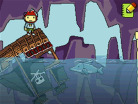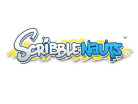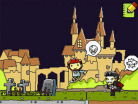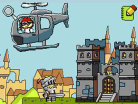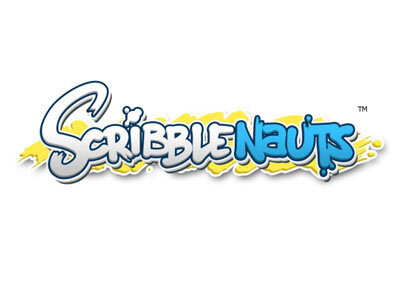- CLASSIC MAGAZINES
- REVIEW CREW
A show recapping what critics thought back
when classic games first came out! - NEXT GENERATION'S BEST & WORST
From the worst 1-star reviews to the best
5-stars can offer, this is Next Generation! - NINTENDO POWER (ARCHIVE)
Experience a variety of shows looking at the
often baffling history of Nintendo Power! - MAGAZINE RETROSPECTIVE
We're looking at the absolutely true history of
some of the most iconic game magazines ever! - SUPER PLAY'S TOP 600
The longest and most ambitious Super NES
countdown on the internet! - THEY SAID WHAT?
Debunking predictions and gossip found
in classic video game magazines! - NEXT GENERATION UNCOVERED
Cyril is back in this spin-off series, featuring the
cover critic review the art of Next Generation! - HARDCORE GAMER MAGAZING (PDF ISSUES)
Download all 36 issues of Hardcore Gamer
Magazine and relive the fun in PDF form!
- REVIEW CREW
- ELECTRONIC GAMING MONTHLY
- ELECTRONIC GAMING MONTHLY RANKS
From Mario to Sonic to Street Fighter, EGM
ranks classic game franchises and consoles! - ELECTRONIC GAMING MONTHLY BEST & WORST
Counting down EGM’s best and worst reviews
going year by year, from 1989 – 2009! - ELECTRONIC GAMING BEST & WORST AWARDS
11-part video series chronicling the ups and
downs of EGM’s Best & Worst Awards!
- ELECTRONIC GAMING MONTHLY RANKS
- GAME HISTORY
- GAME OVER: STORY BREAKDOWNS
Long-running series breaking down game
stories and analyzing their endings! - A BRIEF HISTORY OF GAMING w/ [NAME HERE]
Real history presented in a fun and pithy
format from a variety of game historians! - THE BLACK SHEEP
A series looking back at the black sheep
entries in popular game franchises! - INSTANT EXPERT
Everything you could possibly want to know
about a wide variety of gaming topics! - FREEZE FRAME
When something familiar happens in the games
industry, we're there to take a picture! - I'VE GOT YOUR NUMBER
Learn real video game history through a series
of number-themed episodes, starting at zero! - GREAT MOMENTS IN BAD ACTING
A joyous celebration of some of gaming's
absolute worst voice acting!
- GAME OVER: STORY BREAKDOWNS
- POPULAR SHOWS
- DG NEWS w/ LORNE RISELEY
Newsman Lorne Riseley hosts a regular
series looking at the hottest gaming news! - REVIEW REWIND
Cyril replays a game he reviewed 10+ years
ago to see if he got it right or wrong! - ON-RUNNING FEUDS
Defunct Games' longest-running show, with
editorials, observations and other fun oddities! - DEFUNCT GAMES QUIZ (ARCHIVE)
From online quizzes to game shows, we're
putting your video game knowledge to the test!- QUIZ: ONLINE PASS
Take a weekly quiz to see how well you know
the news and current gaming events! - QUIZ: KNOW THE GAME
One-on-one quiz show where contestants
find out if they actually know classic games! - QUIZ: THE LEADERBOARD
Can you guess the game based on the classic
review? Find out with The Leaderboard!
- QUIZ: ONLINE PASS
- DEFUNCT GAMES VS.
Cyril and the Defunct Games staff isn't afraid
to choose their favorite games and more! - CYRIL READS WORLDS OF POWER
Defunct Games recreates classic game
novelizations through the audio book format!
- DG NEWS w/ LORNE RISELEY
- COMEDY
- GAME EXPECTANCY
How long will your favorite hero live? We crunch
the numbers in this series about dying! - VIDEO GAME ADVICE
Famous game characters answer real personal
advice questions with a humorous slant! - FAKE GAMES: GUERILLA SCRAPBOOK
A long-running series about fake games and
the people who love them (covers included)! - WORST GAME EVER
A contest that attempts to create the worst
video game ever made, complete with covers! - LEVEL 1 STORIES
Literature based on the first stages of some
of your favorite classic video games! - THE COVER CRITIC
One of Defunct Games' earliest shows, Cover
Critic digs up some of the worst box art ever! - COMMERCIAL BREAK
Take a trip through some of the best and
worst video game advertisements of all time! - COMIC BOOK MODS
You've never seen comics like this before.
A curious mix of rewritten video game comics!
- GAME EXPECTANCY
- SERIES ARCHIVE
- NINTENDO SWITCH ONLINE ARCHIVE
A regularly-updated list of every Nintendo
Switch Online release, plus links to review! - PLAYSTATION PLUS CLASSIC ARCHIVE
A comprehensive list of every PlayStation
Plus classic release, including links! - RETRO-BIT PUBLISHING ARCHIVE
A regularly-updated list of every Retro-Bit
game released! - REVIEW MARATHONS w/ ADAM WALLACE
Join critic Adam Wallace as he takes us on a
classic review marathon with different themes!- DEFUNCT GAMES GOLF CLUB
Adam Wallace takes to the links to slice his way
through 72 classic golf game reviews! - 007 IN PIXELS
Adam Wallace takes on the world's greatest spy
as he reviews 15 weeks of James Bond games! - A SALUTE TO VAMPIRES
Adam Wallace is sinking his teeth into a series
covering Castlevania, BloodRayne and more! - CAPCOM'S CURSE
Adam Wallace is celebrating 13 days of Halloween
with a line-up of Capcom's scariest games! - THE FALL OF SUPERMAN
Adam Wallace is a man of steel for playing
some of the absolute worst Superman games! - THE 31 GAMES OF HALLOWEEN
Adam Wallace spends every day of October afraid
as he reviews some of the scariest games ever! - 12 WEEKS OF STAR TREK
Adam Wallace boldly goes where no critic has
gone before in this Star Trek marathon!
- DEFUNCT GAMES GOLF CLUB
- DAYS OF CHRISTMAS (ARCHIVE)
Annual holiday series with themed-episodes
that date all the way back to 2001!- 2015: 30 Ridiculous Retro Rumors
- 2014: 29 Magazines of Christmas
- 2013: 29 Questionable Power-Ups of Christmas
- 2012: 34 Theme Songs of Christmas
- 2011: 32 Game Endings of Christmas
- 2010: 31 Bonus Levels of Christmas
- 2009: 30 Genres of Christmas
- 2008: 29 Controls of Christmas
- 2007: 34 Cliches of Christmas
- 2006: 33 Consoles of Christmas
- 2005: 32 Articles of Christmas
- 2004: 31 Websites of Christmas
- 2003: 29 Issues of Christmas
- 2002: 28 Years of Christmas
- 2001: 33 Days of Christmas
- NINTENDO SWITCH ONLINE ARCHIVE
- REVIEW ARCHIVE
- FULL ARCHIVE
Scribblenauts
Scribblenauts is the type of game I should be head over heels for. The game is a true testament of what can be done with video games, definitively proving that not everything has been done before. Better still, the game oozes with personality, has an infinite amount of replay and can be enjoyed by just about everybody. This is the type of game that I usually champion. So why is it that I love the concept so much, but just can't get into the game?
The gameplay is fueled by an intoxicating idea: Whatever you can spell can be created and used to solve puzzles. That's no joke, thanks to the game's 10,000 word dictionary; you can create whatever you want. UFOs, tigers, vampires, zombies, boulders, submarines, God ... whatever. Need to reach a star on the top of a house? Simply use a jet pack (or wings, a helicopter, ladder, or ...). If you need to reach a star in the water you can use a scuba suit. Need to get a star out of a tight spot? Tie it to a cat and then create a mouse for it to chase. The puzzle solutions are nearly limitless, you can solve each of them in dozens (if not hundreds) of extremely creative ways.
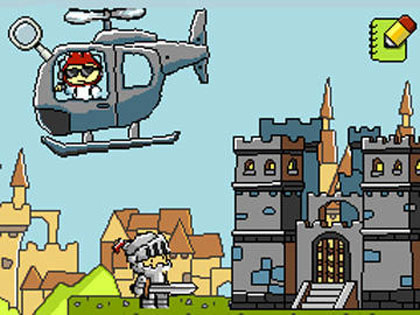
Your typical puzzle level will give you a hint and then expect you to figure it out. To create you have to pull up the game's keyboard, type out a word and like magic that item appears on the screen. You can move the object around, make it interact with your character and even tie it to other objects. You are limited by how many different objects you can create at any one time, and like golf the object is to have the lowest score possible. The game certainly gives you enough room to experiment, so I never felt like I was being boxed in with too few objects.
Scribblenauts has two completely different game modes to play around in. The first is the aforementioned puzzle mode. The other is the action mode, which places a star in the level and has you try and figure out how to retrieve it. The trick to these levels is that you will often have to traverse tough terrain and tricky obstacles in order to collect the star. Unfortunately these levels are nowhere near as exciting as the puzzle mode. Part of the problem is that too many of the levels can be accomplished using the same few words over and over. I also found that there wasn't much room for creativity in these levels, something that immediately turned me off of these tiresome levels. While I wouldn't call the action levels bad, they come off as unnecessary filler when compared to the superior puzzle mode.
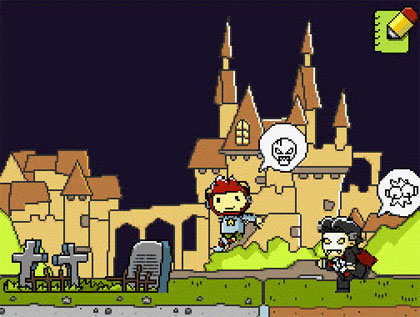
These two modes provide a staggering amount of levels, more than 200 different puzzles for you to solve. And if that wasn't enough, you'll also find a level editor which gives you the ability to test out your craziest ideas and try and trick your friends. Before even attempting to beat the hundreds of puzzle and action levels, I found myself hooked on the freedom offered to me in the level editor. It's here, without any of the shackles associated with the actual puzzle modes, that I had the most fun. It was in this mode where I could be my most creative; it gave me free reign to literally try anything and everything I could think of, often without limits. I can see gamers getting hooked on the freedom given to them in this mode, so much so that it makes the rest of the game feel a little too controlled. If only there was a way to combine this freedom with the structure of the action/puzzle modes we would really be on to something amazing.
No matter how good the concept is, innovation cannot make up for bad gameplay. Right from the get-go you'll discover the game's biggest flaw - it relies too heavily on the touch screen. This is one of those games that has you doing just about everything with the stylus, from starting the levels to creating items to moving your character. This means that once you've created (and dropped) a few items, you will need to click and drag your character all around the level. Sometimes this works, such as when you are only dealing with large objects and performing uncomplicated moves. However, too often you'll discover that it's far too easy to select the wrong thing, tell your character to go to the wrong place and ultimately mess up your entire plan. This ranges from being annoying to downright infuriating.
Things go from bad to worse when you create one of the many vehicles your character can use. I'm sure piloting a helicopter in real life is no easy task, but doing it in Scribblenauts is next to impossible. It's far too easy to accidentally click on the vehicle and eject yourself at the wrong time. And don't even get me started on all of the times my vehicle flipped over or glitched out. It's enough to make you not want to use some of the game's words, but you'll need to in order to actually beat the game. Had the developers had the foresight to simply move the character's control to the D-pad none of this would have been an issue, however, that's not what they did and gamers are now forced to deal with one of the worst control set-ups of the year.

Aside from the disastrous controls, the game has a unique style that works well on the underpowered Nintendo DS. Scribblenauts look combines the cartoony look of cel-shaded graphics with the 2D plain, giving gamers a flat (albeit artistic) look. You will never be blown away with how the game looks, but it's never about the visual fidelity. Instead you are excited by the little things, like what a particular object may look like or how one similar item my compare to another. Even if this game was on a more powerful console, I would hope that the artistic style would be retained.
Unfortunately, I spent a lot of my time wanting the game to be on a different system. As I sat there constantly dying because of the poor control scheme, I wondered if I might have a better time on a larger screen. Even if they didn't change a thing for a PC port, the larger screen and more precise mouse controls would do this game a lot of good. Simply put, the game is held back by the limitations of the Nintendo DS touch screen.
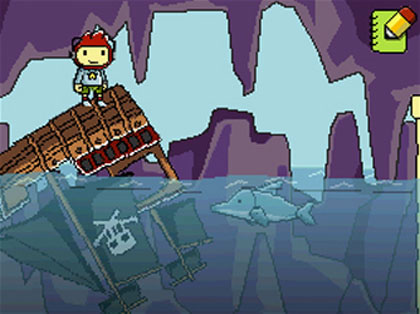
If you can get past the annoying control scheme, you'll find that Scribblenauts offers an amazing concept that almost matches its potential. This installment feels more like an experiment; a proof of concept, if you will. With a little more structure and a better control scheme this could be one of the very best games around. Hopefully the game will sell enough to warrant a second game that fixes all of these problems, because THAT would be a great game to own. This, on the other hand, is a fun game that ultimately misses its mark.
HOME |
CONTACT |
NOW HIRING |
WHAT IS DEFUNCT GAMES? |
NINTENDO SWITCH ONLINE |
RETRO-BIT PUBLISHING
Retro-Bit |
Switch Planet |
The Halcyon Show |
Same Name, Different Game |
Dragnix |
Press the Buttons
Game Zone Online | Hardcore Gamer | The Dreamcast Junkyard | Video Game Blogger
Dr Strife | Games For Lunch | Mondo Cool Cast | Boxed Pixels | Sega CD Universe | Gaming Trend
Game Zone Online | Hardcore Gamer | The Dreamcast Junkyard | Video Game Blogger
Dr Strife | Games For Lunch | Mondo Cool Cast | Boxed Pixels | Sega CD Universe | Gaming Trend
Copyright © 2001-2025 Defunct Games
All rights reserved. All trademarks are properties of their respective owners.
All rights reserved. All trademarks are properties of their respective owners.






